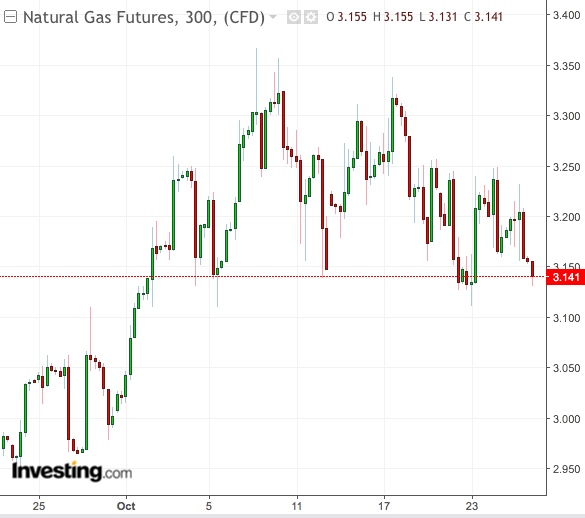In the 1944 winter classic Baby, It’s Cold Outside, an amorous host keeps convincing his guest to stay the evening, saying it’s frigid outdoors, with her admitting it’s nice and warm inside. Natural Gas bulls can relate somewhat to both sides of the repartee in that song: It’s kind of cold outside now but it’s also warm indoors—without heating, unfortunately.

Since pushing natural gas futures on the New York Mercantile Exchange to above the $3 per million metric British thermal units (mmBtu) in late September, those long the market have managed to keep it at that psychologically-important level despite record high production of the fuel. In their favor was a late blast of summer heat that forced more gas to be burnt to keep air-conditioners humming into early autumn, than be stored in underground caverns awaiting winter.
That heat is now gone. And in its place is mixed weather, ranging from a somewhat cold 45 degrees Farenheit to a warm 65 degrees (7 to 18 Celcius).
According to Reuters, there were 82 heating degree days (HDDs) last week, compared with 38 HDDs in the same week a year ago and a 30-year normal of 55HDDs for the period. HDDs measure the number of degrees a day's average temperature is below 65 degrees and is used to estimate demand to heat homes and businesses.
Not Cold Enough To Push Gas Burn Rates Higher
US dry natural gas production is expected to rise to an all-time high of 82.67 bcf a day in 2018 from 74.77 bcf per day in 2017, according to government forecasts.
While the HDD readings for last week were above normal, to keep the market at above $3 per mmBtu amid record production, even more gas has to be burnt each week, analysts say.
And that can’t happen unless the weather gets much colder.
“Overall, I find it hard to have a strong view on the market without a real strong view on the weather forecast,” said Scott Shelton, a natural gas specialist and broker for energy futures at ICAP) in Durham, North Carolina. He added:
“While we can prognosticate on what ‘could happen if’ it’s cold, the more probable outcome is either normal or above , with below normal temps having a 33 percent chance of the three possible outcomes, if you are agnostic to the noise of weather models and weather consultants.”
Dominick Chirichella, director of trading and risk management at the Energy Management Institute in New York, also has a bearish outlook on the near-term weather for gas. Chirichella said:
“The latest short-term temperature forecast issued today is less supportive than yesterday’s projection. The forecast is projecting below normal temperatures over the middle of the country but normal to above normal temperatures in the high population areas of the US. The call on NatGas for heating related demand should be below normal for this time of the year and during this forecast period.”
Injection Rates Building Up
Injection rates of gas into storage are, meanwhile, slowly building after being abnormally low through the summer.
Storage for last week closed at 3.095 trillion cubic feet, after an injection of 58 billion cubic feet (bcf). Market participants had expected a build of 51 bcf. Despite the higher number, NYMEX’s front-month gas contract settled up 3.6 cents at $3.202 per mmBtu as traders viewed the higher injection as still below the five-year norm of 77 bcf.
There are “at least three, and possibly four, injections left before the weather gets cold enough to force net withdrawals from storage,” said Dan Myers, gas analyst at Gelber & Associates in Houston.
While current weekly injections were still below the five-year average, “robust production continues to make itself felt through injections that exceed model predictions,” he added.
